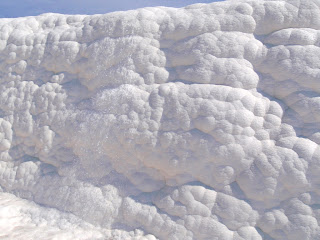On Thursday we spent the day in Pammukale, roughly 175 km East (inland) of Ephesus. More aptly, we spent our time exploring the ruins of Hieropolis, a Roman city founded around 190 BCE. Hieropolis was known as a cure center, famous for its sacred pools that were fed by warm calcium-rich mineral water from natural hot springs up the mountainside. The city sits atop a plateau overlooking an amazing natural phenomenon: thousands of years of mineral-rich water seeping down the mountainside have left massive deposits of calcium that have quite literally turned the cascading hillside white. A series of pools known as "travertines" collect the water, and these pools were/are used for bathing. There was also a massive pool in the city into which the same water was fed (now a tourist bath).
Looking up at the travertines from below.
 That's me, in the snow.... I mean, uhh, calcium deposits?
That's me, in the snow.... I mean, uhh, calcium deposits? PJ and Karel
PJ and Karel Water seeps down the hillside, feeding pools along the way
Water seeps down the hillside, feeding pools along the way

 Above, Hieropolis back in the day. Below, ruins on main street
Above, Hieropolis back in the day. Below, ruins on main street Below, a temple
Below, a temple A sarcophagus, buried under centuries of calcium. This is the view looking out from the city... an amazing vantage point.
A sarcophagus, buried under centuries of calcium. This is the view looking out from the city... an amazing vantage point. Below, looking back uphill at ruins of Roman baths
Below, looking back uphill at ruins of Roman baths
Below, Karel in the Agora (marketplace)... quite the happening spot at one time

 I have fallen in love with Roman theatres. I could sit here all day. From an architectural standpoint, not a whole heck of a lot has changed since 100 BCE. The acoustics are fantastic! You can hear a person talking on stage from the highest rows. This theatre held about 12,000 spectators.
I have fallen in love with Roman theatres. I could sit here all day. From an architectural standpoint, not a whole heck of a lot has changed since 100 BCE. The acoustics are fantastic! You can hear a person talking on stage from the highest rows. This theatre held about 12,000 spectators.
 Me, clapping.... all by myself. Good show! No takers.... ok, yes, I am a dork.
Me, clapping.... all by myself. Good show! No takers.... ok, yes, I am a dork.
Aside from the theatre, my other favorite part of Hieropolis is pictured below. This was once a temple of Apollo... and as at Delphi it had an Oracle, tended by Eunuch priests. On the opposite side of the structure was an adjoining spring called the Plutonium... dedicated to Pluto, god of the underworld, and said to be the source of the Oracle's inspiration. The bubbling spring gave off toxic vapors and, believe it or not, still bubbles today. You cannot see the spring, as it is enclosed in stone for safety, but there is a small hole in the front and if you put your ear up to the hole the blurble-blip-blurble of of the Plutonium can still be heard! I can see how this was understood to be a link to the underworld. Pretty amazing place.
 Above, a roman "pipe", meant to carry water for the city pools, I imagine.
Above, a roman "pipe", meant to carry water for the city pools, I imagine.
 The travertines, cascading down the hillside
The travertines, cascading down the hillside


 Above, a roman "pipe", meant to carry water for the city pools, I imagine.
Above, a roman "pipe", meant to carry water for the city pools, I imagine. The travertines, cascading down the hillside
The travertines, cascading down the hillside
From Pammukale we caught the bus out to Selcuk on the coast, the town next to the famous ruins of the great Ephesus.
No comments:
Post a Comment